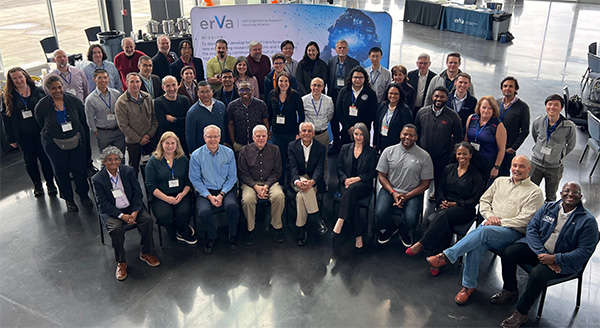To succeed in the future, American manufacturing must mobilize engineering research to improve productivity, agility, and competitiveness.
By Charles Johnson-Bey, Ph.D., Co-Principal Investigator, Engineering Research Visioning Alliance (ERVA); Senior Vice President, Booz Allen Hamilton
Envisioning the future of U.S. manufacturing from an engineering research viewpoint was the purpose of the March 2023 event convened by the Engineering Research Visioning Alliance (ERVA), an initiative funded by the U.S. National Science Foundation (NSF). The event convened 56 participants (from small- to medium-sized manufacturing companies, plus researchers and technical experts from industry, government, and academia) to identify critical areas for engineering research in distributed manufacturing. This refers to the development of technologically advanced industry located within the U.S., widely distributed locally to maximize flexibility in the event of supply chain disruptions, and more sustainable than current global networks. The event’s findings were published in October in a report, Engineering the Future of Distributed Manufacturing.

Manufacturing in the United States has been on a 50-year downward trend as firms have offshored production. With a loss of more than 30% of manufacturing jobs since 1970 and the sector’s share of GDP shrinking from 27% to 12%, U.S. manufacturers may be forgiven for thinking the future is one of either moving production overseas or, if one is a small- or medium-sized firm unable to offshore, folding operations altogether. More recently, rising geopolitical tensions and risks have made offshoring less tenable. Moreover, the supply chain nightmares triggered by the COVID-19 pandemic drove home the critical need for increasing domestic and distributed manufacturing capability that can respond quickly to economic shocks.
Savvy manufacturers recognize these dangers. U.S. government policy, such as the 2022 CHIPS and Science Act, aims to encourage investment in domestic manufacturing growth and innovation. But those incentives are limited. Legacy facilities, especially those with human-intensive production lines, will simply not be able to compete with Industry 4.0 – cyberphysical systems, the Internet of Things (IoT), cloud computing, artificial intelligence (AI), and machine learning (ML). Industry 5.0 is an even greater leap; it will combine human and machine intelligence to create a more personalized consumer experience at scale.
The report focuses on three crucial areas: (A) materials supply chains that are secure and distributed; (B) tools and processes to create any discrete manufacturing product/tool anywhere, and in any lot size, without loss of quality; and (C) data and quality assurance to improve the efficiency of production processes regardless of lot size, optimize inventory management, reduce downtime, and enhance the quality of products and services. To drive progress across all these areas, manufacturers and engineers should take five actions:
U.S. manufacturing can have a strong future – but it will require innovative vision and cross-functional, cross-industry collaboration to survive and thrive. ERVA’s latest report is a call to action on that front, and one America’s manufacturers should heed.

Charles Johnson-Bey
Co-Principal Investigator, ERVA; Senior Vice President, Booz Allen Hamilton
As a senior vice president for Booz Allen Hamilton, Charles Johnson-Bey develops and executes innovative technology strategies that position the company as a leader in the development of next-generation solutions that are recognizable and branded in the market. He is also co-principal investigator the Engineering Research Visioning Alliance (ERVA), a five-year, NSF-funded initiative that convenes, catalyzes and empowers the U.S. engineering community to identify nascent opportunities and priorities for engineering-led innovative, high-impact, cross-domain, fundamental research that addresses national, global and societal needs.
Johnson-Bey has over 25 years of engineering experience that includes emerging technologies in information warfare, cyber resilience, digital signal processing, system architecture, prototyping, and hardware. He has worked for Lockheed Martin Corporation, Motorola Corporate Research Labs, Corning Incorporated Science & Technology Division, and he served as an electrical engineering professor at Morgan State University. He earned a bachelor’s degree in electrical and computer engineering from Johns Hopkins University and both master’s and doctorate degrees in electrical engineering from the University of Delaware.
He received the 2018 Black Engineer of the Year Award for Career Achievement- Industry. He is on several boards including the Whiting School of Engineering Advisory Board at Johns Hopkins University and the Electrical and Computer Engineering Advisory Boards at both Johns Hopkins University and the University of Delaware. He is also on the Cybersecurity Institute Advisory Board for the Community College of Baltimore County.
From tradition to transformation Sequoia Brass & Copper has stood for excellence in American manufacturing. In this episode, we sit down with Kim MacFarlane, President of Sequoia Brass & Copper, to hear the inspiring story of a family-owned company founded by her father, built on craftsmanship, trust, and a relentless commitment to quality. Kim shares how she’s guided the company through the challenges of modern industry while honoring its heritage, and how the next chapter will be carried forward by her son Kyle. This is more than a story of brass and copper; it’s about resilience, innovation, and the enduring strength of family legacy. If you’ve ever wondered how tradition can meet the demands of today’s industry hit play and be inspired.